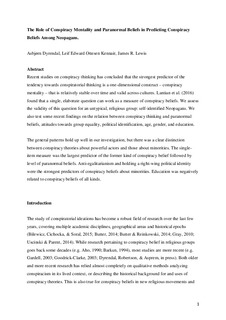| dc.contributor.author | Dyrendal, Asbjørn | |
| dc.contributor.author | Kennair, Leif Edward Ottesen | |
| dc.contributor.author | Lewis, James R | |
| dc.date.accessioned | 2019-03-13T08:16:49Z | |
| dc.date.available | 2019-03-13T08:16:49Z | |
| dc.date.created | 2018-07-12T10:24:41Z | |
| dc.date.issued | 2018 | |
| dc.identifier.citation | International Journal for the Study of New Religions. 2018, 8 (1), 73-97. | nb_NO |
| dc.identifier.issn | 2041-9511 | |
| dc.identifier.uri | http://hdl.handle.net/11250/2589782 | |
| dc.description.abstract | Recent studies on conspiracy thinking has concluded that the strongest predictor of the tendency towards conspiratorial thinking is a one-dimensional construct-conspiracy mentality-that is relatively stable over time and valid across cultures. Lantian et al. (2016) found that a single, elaborate question can work as a measure of conspiracy beliefs. We assess the validity of this question for an untypical, religious group: self-identified Neopagans. We also test some recent findings on the relation between conspiracy thinking and paranormal beliefs, attitudes towards group equality, political identification, age, gender, and education. The general patterns hold up well in our investigation, but there was a clear distinction between conspiracy theories about powerful actors and those about minorities. The single-item measure was the largest predictor of the former kind of conspiracy belief followed by level of paranormal beliefs. Anti-egalitarianism and holding a right-wing political identity were the strongest predictors of conspiracy beliefs about minorities. Education was negatively related to conspiracy beliefs of all kinds. | nb_NO |
| dc.language.iso | eng | nb_NO |
| dc.publisher | Equinox Publishing | nb_NO |
| dc.title | The Role of Conspiracy Mentality and Paranormal Beliefs in Predicting Conspiracy Beliefs Among Neopagans | nb_NO |
| dc.title.alternative | The Role of Conspiracy Mentality and Paranormal Beliefs in Predicting Conspiracy Beliefs Among Neopagans | nb_NO |
| dc.type | Journal article | nb_NO |
| dc.type | Peer reviewed | nb_NO |
| dc.description.version | acceptedVersion | nb_NO |
| dc.source.pagenumber | 73-97 | nb_NO |
| dc.source.volume | 8 | nb_NO |
| dc.source.journal | International Journal for the Study of New Religions | nb_NO |
| dc.source.issue | 1 | nb_NO |
| dc.identifier.doi | 10.1558/ijsnr.36716 | |
| dc.identifier.cristin | 1596843 | |
| dc.description.localcode | © 2018. This is the authors’ accepted and refereed manuscript to the article. Locked until 27.7.2020 due to copyright restrictions. | nb_NO |
| cristin.unitcode | 194,62,70,0 | |
| cristin.unitcode | 194,67,40,0 | |
| cristin.unitname | Institutt for filosofi og religionsvitenskap | |
| cristin.unitname | Institutt for psykologi | |
| cristin.ispublished | false | |
| cristin.fulltext | postprint | |
| cristin.qualitycode | 1 | |
